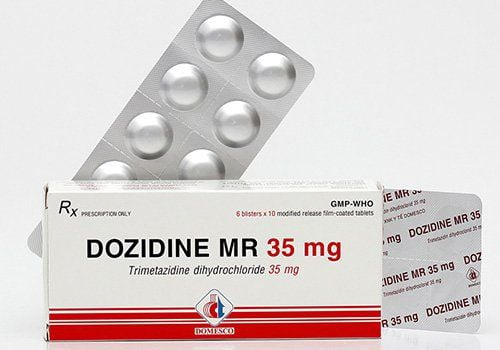This is an automatically translated article.
The article was professionally consulted by a Doctor of Cardiology - Thoracic Surgery, Vinmec Central Park International General Hospital.Medically, stable and unstable angina are both manifestations of coronary artery disease. Depending on the cause of the disease, there will be specific symptoms, however, patients need to distinguish whether they have stable or unstable angina to get the right and timely treatment plan.
1. What is stable angina?
Stable angina usually occurs in the posterior region of the sternum and is the result of fixed coronary artery stenosis and stable atherosclerotic plaques. This is because when the coronary arteries are narrowed, the blood flow to the heart muscle is reduced, leading to chest pain. The pain will appear when the patient is active or psychologically burdened.Stable angina often causes the patient to have sudden chest pain, unable to continue the work they are doing, stop all activities. Feeling of chest pain as if something is squeezing, pressing on the back of the breastbone or on the side of the heart. The pain may radiate to the shoulders, up the sides of the lower jaw, to the inside of the left hand, or to the neck. There are also a few cases, the patient may feel pain in the right side, epigastrium, mistaken for acute stomach pain.
For stable angina, the patient just needs to rest in moderation, helping the heart rate to slow down, the coronary arteries will meet the myocardial oxygen demand and completely reduce the pain.

Đối với những cơn đau thắt ngực ổn định thì người bệnh chỉ cần nghỉ ngơi thì cơn đau sẽ giảm
2. What is unstable angina?
Unlike stable angina, unstable angina often occurs suddenly even when the patient is resting, psychologically comfortable, often causing pain at night and in the morning.Unstable angina, also known as acute coronary syndrome, is very dangerous, appearing due to a sudden decrease in coronary blood flow to the myocardium, which is usually caused by the rupture of atherosclerotic plaque leading to occlusion. sudden occlusion of all or part of the lumen. This is a situation that requires urgent medical attention.
Symptoms of unstable angina are often more intense and last longer than those of stable angina. The pain will tend to come on more and more with increasing pain, which can get worse over a very short period of time.
Therefore, if the pain lasts more than 15 minutes and there is no sign of relief, the patient should be taken to the nearest medical facility for timely emergency, avoiding the risk of arrhythmia, myocardial infarction. cardiac arrest or sudden death.
Unstable angina is usually characterized by the following symptoms:
A sharp pain in the left side of the heart that radiates to the arm or behind the breastbone, neck or jaw; Accompanied by pain, the patient also has abdominal distension, indigestion, nausea, shortness of breath, palpitations, dizziness, cold sweats in the head and neck area; The pain is persistent, sudden, and usually lasts more than 15 minutes. Unstable angina is extremely dangerous, it not only causes acute myocardial infarction but also can cause sudden death if not treated promptly. Even with timely emergency treatment, the possibility of sequelae is quite severe.
In order to have the right treatment plan, it is necessary to determine the cause of unstable angina. The cause will be accurately diagnosed through subclinical and imaging tests such as: chest MRI, CT-scan, ultrasound, electrocardiogram, X-ray, ....

Các cơn đau thắt ngực không ổn định vô cùng nguy hiểm, có thể gây nhồi máu cơ tim, thậm chí là tử vong
3. Prevention of stable and unstable angina
While stable angina is predictable and not directly life-threatening, unstable angina is often a warning sign of a heart attack, which will not go away on its own. , even when the patient is resting and taking a vasodilator. If not treated promptly, unstable angina can be life-threatening.Therefore, the prevention of stable and unstable angina is extremely necessary and important. Here are some recommended preventive measures:
Changing habits and lifestyle of living, eating; Daily exercise to improve health; Control the weight regime in moderation; Limiting the body to be in a state of anxiety, stress, stress for too long; Limit the use of foods high in cholesterol, rich in fat from red meat, animal organs, skin, animal brain marrow, egg yolks, fat, intestines, shellfish, shellfish...; Do not use too much alcohol, caffeine, quit smoking and say no to stimulants; In cases where ischemic heart disease has been and is present, it should be treated regularly and strictly according to the instructions of the doctor; Regularly use foods from the group of green vegetables and fresh fruits; Periodic health check-up for effective disease screening. When seeing signs of angina, especially unstable angina, the patient should see a doctor to find out the cause of this phenomenon, so that appropriate intervention can be taken. Vinmec International General Hospital is the right choice for the examination and treatment of cardiovascular diseases, including angina.
Here, a team of qualified, experienced and well-trained medical doctors will examine, diagnose and advise patients with advanced and modern methods; with the support of modern technological equipment, ensuring the most accurate results.
Please dial HOTLINE for more information or register for an appointment HERE. Download MyVinmec app to make appointments faster and to manage your bookings easily.













